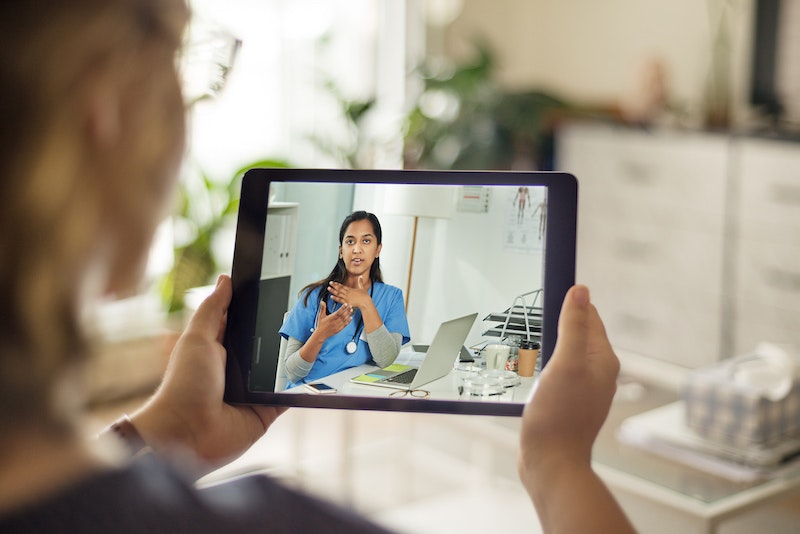From streaming the latest movies to buying a new laptop or ordering Latvian takeout, you can do a staggering number of things without leaving your couch these days. And more people are realizing you can also talk with a doctor — about diagnosis, a treatment plan, and prescriptions — without stepping outside. That’s convenient anytime, but especially now during the COVID-19 situation –– right now, it may be best to stay away from hospitals and medical clinics, unless you really need to be there.
“Virtual care appears to be a low-cost alternative to care administered in other settings,” as long as an in-person service, such as a test, exam, or procedure, isn’t needed, according to a study in the Journal of Medical Internet Research. When researchers compared virtual visits with in-person visits, they found similar follow-up rates, which suggests “adequate clinical resolution” — in other words, people had their needs met, without needing to step outside.
That’s great news when getting to the doctor would be inconvenient, logistically impossible, or even put your health, or others’, at risk. The Centers for Disease Control and Prevention (CDC) advises that if you believe you might have been exposed to COVID-19, and have symptoms that don’t require urgent or emergency care, call your primary care provider right away. Your provider may offer a telehealth option and determine whether additional testing is needed. (During the current emergency, many health insurance companies are waiving or lowering costs for COVID-19-related telehealth services.)
During the coronavirus outbreak, for instance, state and local governments are strongly encouraging people to avoid gatherings and to keep their distance socially. Yet routine health visits are still necessary, whether that’s a diabetes check-up, a dermatology follow-up, or a therapy appointment. Virtual visits may solve some of those dilemmas, by giving you access to your health care without risking coming into contact with anyone.
Also known as telemedicine or telehealth, this type of service typically connects patients to providers through secure video or phone calls, using the patient’s mobile phone or computer. And it’s becoming more popular: 82 percent of large companies cover services through telemedicine, up from 39 percent just three years ago, according to a report by the Kaiser Family Foundation.
Of course, wait times may be a bit longer as more people want to use virtual visits during the pandemic. If you are experiencing COVID-19 symptoms, the CDC recommends calling your primary care doctor first. If you want to try a virtual doctor visit, you might have access through your provider, your insurance, or a telehealth company. Taking advantage of virtual visits might be less expensive, too.
If you’re unfamiliar with virtual visits, you might have questions: When does it make sense? How does it work? What does it cost? Read on for more information.
The When and Why
Medical emergencies — say, a suspected heart attack or a broken bone — are not what virtual visits are designed for. Even if you’re not facing an emergency, some health issues still require an in-person visit, because your doctor might want to do a physical exam or order certain tests, such as blood work or an MRI.
But virtual visits allow you to connect with a primary care physician or other provider when you don’t require a physical exam. “If you think about all the encounters you have in health care, that’s a considerable amount,” says Joseph Brennan, telehealth consultant at Moonshot Health Consulting and a member of the American Telemedicine Association Advisory Council.
They can also be used for consultations, follow-ups after procedures, chronic condition management, and medication management. If you’re unsure whether your symptoms require an in-person visit to the doctor (or even a visit to an urgent care center), a quick telehealth consultation can also get you an expert opinion on the appropriate care path, says Brennan. And research suggests that the smart use of virtual visits may actually improve overall health outcomes, without sacrificing how satisfied people are with their physician interactions.
You might think that providers for virtual visits would be limited to primary care doctors or generalists. But don’t assume just because your issue is more specialized that you need to venture out of house. There are many types of specialists who will talk to patients by video or phone, including psychiatrists, dermatologists, and neurologists. Some specialties, like psychiatrists and therapists, may be able to perform full counseling sessions through virtual visits, says Brennan, while other specialties, like dermatology and gynecology, rely on them for consultations or follow-up visits.
The How
It’s always worthwhile to get a quick overview of your virtual visits options, while you’re healthy. That means you won’t have to navigate a new-to-you platform while also dealing with pink eye symptoms, say, or a low-grade fever.
Start by calling your primary care physician. If your primary care provider has the capacity, you may be able to schedule virtual visits directly with them through a telehealth platform. If you can’t connect virtually with your primary care doctor, head to your health care insurance website to get a sense of your options. Here, you might learn you have access to direct-to-consumer telemedicine that has longer hours than your regular doc — even 24/7 availability, in some cases, with a range of on-call physical and mental health care providers available at your fingertips. While connecting with your own provider might require an advance appointment, many telehealth services can quickly connect you with an on-call doctor.
Virtual visits often take the form of a live video conference, which works in many ways like a regular visit, except that the patient and provider will be speaking through a computer screen, rather than face to face. The care provider and patient can chat live about symptoms and health concerns, and doctors can even prescribe or refill basic medication.
To get the most out of your virtual visit, set yourself up in a private space, to minimize distractions and help you feel most comfortable sharing health details with a provider, says Brennan. Put your laptop or mobile device on a level surface, such as a table, to decrease wobbling and shaking. And make sure you appear well-lit on the screen, which helps your doctor see you and potentially verify symptoms.
The Follow-up
Depending on your insurance coverage, virtual visits can be even more cost-effective than heading to an in-person visit. A 2019 study in the American Journal of Emergency Medicine found that people saved between $19 and $121, on average, when using telemedicine. Both Medicare and Medicaid usually pay for some telehealth services, depending on the circumstances. And, in response to the coronavirus pandemic, many health insurance companies have waived copays for virtual visits for the near future.
“Commercial insurance companies have really started to pay for virtual visits,” says Brennan. “Just in the last two years, we’ve seen a huge jump in commercial reimbursement, as well as improvement with Medicare and Medicaid.”
Aside from finances, it’s important to keep in mind that your primary care doc might not necessarily know that you had a virtual visit. It’s always a good idea to update your primary physician about any diagnosis or treatments you had with another provider, as well as any new medications you might be taking. Virtual visits should complement — not conflict with — the ongoing care you get from your primary physician.
KATE ROCKWOOD
Rally Health





